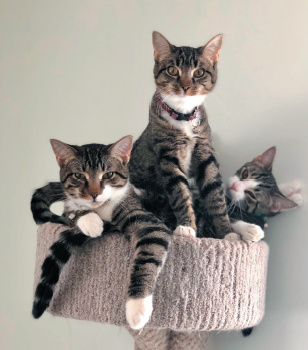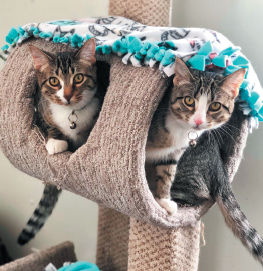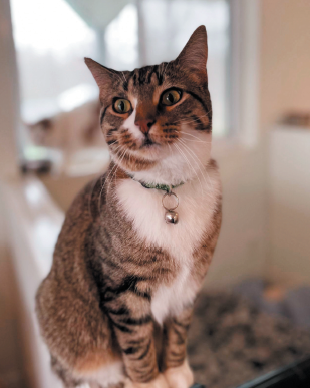Left: What could be sweeter than a kitten? How about this little family of SIX tabby kittens and their mother Trudy! So adorable! Are they any less cute, any less deserving of life because they are positive for leukemia?
In January 2021, we were contacted by Kindred Kitties of Kenosha, Wisconsin—a group that rescues and finds homes for cats. They were hoping that Home for Life® could give Trudy and her kittens a safe landing. The little cat family looked healthy and adorable, but they had tested positive for Feline leukemia (FeLV), a viral disease that can spread to other cats through persistent contact, and is ultimately fatal. Though infected, cats with FeLV can live years without suffering or showing any symptoms of illness.

Trudy and her kittens were currently healthy. But they needed to be kept away from other cats who could catch the disease from them. At the same time, they deserved a good life and a safe home. They had the chance to enjoy many years of good health before becoming actually sick.
Kindred Kitties needed to find a safe landing for all seven cats, with people who recognized that these cats’ lives are as precious as any other cat’s life. Although they knew the cat family deserved a good life and safe home, they had no ready means to help them. And few groups are equipped to help cats like Trudy and her kittens.
How to Mismanage an Epidemic
For many years, rescues and shelters would euthanize cats who received a positive blood screening for FeLV. These groups rationalized their policy, saying so many cats and kittens needed homes that there were just no opportunities for FeLV+ cats—an unacceptable rationale, especially because the blood screening often returns a false positive!
Even though many groups hastened to euthanize cats who tested positive, the disease continued to spread. A reservoir of infection persisted in feral cat colonies, caused in part by some of the groups managing the colonies through TNR (trap-neuter-release) programs. These groups would too often release cats back to their colonies even when they were known to be positive for the virus. Their misguided practice exposed non-infected cats to the virus, and subjected many cats to unnecessary suffering.
In short, both practices (automatic euthanasia and allowing infected cats to spread the disease) have shown a callous disregard for life that is inconsistent with the spirit of animal welfare.
Nine Lives—The Special Role of a Sanctuary

Audrey
Home for Life® has always taken a different approach to addressing problems in animal welfare. We believe that it is impossible to benefit animals as a whole without caring about each individual animal. While we are mindful of the broad factors affecting animal populations, our focus and service have always been directed toward individual animals. And by serving individual animals, we have been able to exert widespread influence on the direction of animal welfare practice.
As a care-for-life sanctuary, we can do things other groups cannot. And we recognized long ago that we could really make a difference for cats by offering a life-saving refuge to FeLV+ cats. Almost 15 years ago, Home for Life® constructed a building dedicated to the care of these special cats and kittens—a space where they can feel cozy and safe, with comfortable furniture, climbing trees, toys, with heated floors in the winter, cooled in the summer, huge windows with ledges to sit in and watch the world, with huge, protected cat runs accessible by cat doors—all tended by a full-time staff who provides loving attentive care.
We always have felt that if people could see our FeLV+ cats, we could change the perception of them among rescues, shelters, and the general public who would realize these cats and kittens didn’t need to be killed based on a screening test. That’s how a sanctuary can show what’s possible and start a movement that saves the lives of cats and dogs previously boxed out of the animal welfare discussion.
Infected cats do not need to be killed out of hand. As long as they are kept quarantined, they can live out their lives safely and comfortably, like any cat. At Home for Life,® we have had several FeLV+ cats enjoy years of good health with no apparent symptoms in spite of being positive for leukemia. Like any cat with nine lives, our FeLV+ cats and kittens often defy the odds, and embody the truth of the sentiment: “Life is short, but it is wide.” Whether they live months or years, these special kittens and cats seem to relish every day of their lives, making the most of every moment, glad to be alive.
It is so meaningful that this family of cats got to stay together, which is something special that sanctuaries can do, unlike organizations with a strong emphasis on adoption—where animals who are devoted friends or family members are often split up to be placed more easily. We were able to keep these close-knit family members together, which helped them transition to their new lives.
Feline leukemia, first discovered in 1964, is a contagious virus that spreads among cats through close persistent contact over a long period of time, through shared grooming, food dishes, nursing, and bites. FeLV is not an airborne virus but can be transmitted from a mother who is positive to her kittens. And that is what happened with Trudy and her six tiger striped kittens.
To this day, there is no treatment for the disease. A vaccine introduced in 1985 has helped limit its spread, but the most effective method of stopping the spread is to separate cats who are positive for leukemia from those who are not. Still, estimates are that about 3% of cats are infected.
The “A” Team
Our new family of feline leukemia kittens is shy but sweet and all variations on a theme of brown tabby and white and all with names beginning with the letter A: Aaron, Alfred Arnold, Andrew, Andrea, and Audrey. To help us distinguish them, we have given each a different colored glitter collar and put together a key, posted in the cattery. It is helping them to transition, to have the support of each other, but we want to get to know them as individuals and not a litter or group. As they became more confident and used to our staff, we have given them the run of the cattery and the outdoor cat runs which they love, and especially now that it’s summer and warm.
Going Viral

Home for Life® has long been known for our care and advocacy on behalf of cats who are positive for leukemia. Quality of life matters even in the face of a virus and the fear it causes. Now we are experiencing this as human beings with Covid. In the animal welfare world, there has been widespread fear and misunderstanding about leukemia that resulted in most cats who tested positive being euthanized based on a screening test. At Home for Life,® we are helping to change that misguided treatment of these cats.
Those who visit us marvel at the beautiful condition and happiness of our cats and kittens. People who meet them in “purrson” can never again dismiss these special kittens and cats as unworthy of life because they are leukemia positive. By showing what’s possible, Home for Life® has created a movement, a lifesaving life-affirming stake in the ground that has gone viral, changing the status quo of these special cats in animal welfare.
The Heartbeat of Home for Life®

The millions of suffering, lonely and unwanted animals are made up of individuals like Trudy and her kittens. Whenever we disregard or devalue one of them, we place all animals in jeopardy, since any dog or cat can lose their home, become old, injured or ill, and unwanted. What keeps animals safe and cherished is our attitude towards them, and our capacity to care. For animals who are vulnerable, everywhere, we can’t turn away from tough cases like feline leukemia-positive cats or consider their fate of negligible consequence. Saving an animal is more than a metaphor. It matters! Whenever you step up for one animal, you are taking a stand for all animals in similar situations. You are demonstrating what is possible. In a system designed to handle problems on a mass scale, individuals can be overlooked. Yet behind every data point and every number is an individual, with a story and the need for someone to recognize all that makes them special.
Home for Life’s® focus on overlooked individuals has enabled us to spot gaps in the animal welfare system where cats or dogs are underserved and vulnerable, to identify where change needs to happen, and where there is opportunity for widespread improvement. No other group of animals we help at Home for Life® represents this focus of our organization more than our feline leukemia cats.
When you help Trudy and her family of tiger kittens, you do so much more than save the lives of seven cats. You show what is possible. You change the status quo for vulnerable cats and dogs everywhere. You become an essential part of the lifesaving, life-affirming movement that is Home for Life®!
Thank you for your support which will change the lives of so many animals in need!
Note: Enjoy some action shots of our feline leukemia kittens in the video below.

